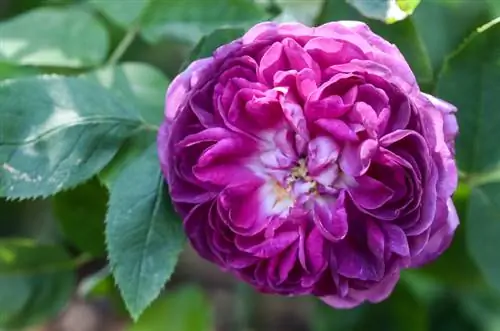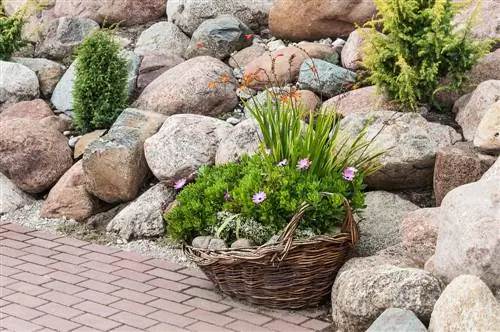- Author admin [email protected].
- Public 2023-12-16 16:46.
- Last modified 2025-01-23 11:22.
High trunks are particularly aesthetic because they deviate from the natural growth habit. They open up new design options and better use of space because a standard tree trunk can be planted underneath. Care measures are important so that the tree does not get out of shape.
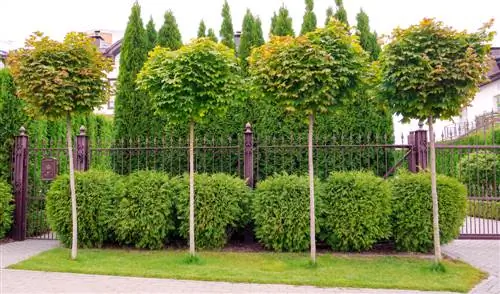
What characterizes standard plants?
High-stem plants are trees whose crown base is 180 to 220 cm high and is achieved through annual pruning. They offer design possibilities, make better use of space and allow for underplanting, but require regular care such as pruning and support.
Which plants are suitable?
In principle, all shrubs are suitable for cultivation as a standard tree. Some trees are more prone to forming side shoots than other trees. Fast-growing trees forgive you mistakes when cutting because they regenerate quickly and make incorrect cuts disappear. If you want to plant the standard tree in the garden, you should prefer winter-hardy trees.
Popular standard species:
- Berry bushes: elderberries, gooseberries and currants
- Coniferous trees: thuja, mountain pine, juniper
- Roses: 'Rose de Resht', 'Leonardo da Vinci', 'Nostalgia'
- Willows: Harlequin Willow, Japanese Ornamental Willow
potted plants
High stems in pots are a classic because they set accents on the terrace and balcony. Mediterranean and summer-flowering shrubs are usually trained as standard trees. Lantana, olive trees and citrus trees are popular. But small magnolias and almond trees also thrive in pots. These trees are not refined, but rather pruned accordingly when they are young. What is important is a stable vessel and compliance with annual care measures. Potted plants overwinter in a protected place.
High stems can be planted in the garden or cultivated in a container. In both cases, regular cuts are necessary.
Design options
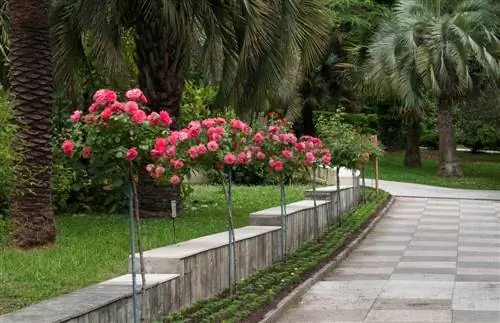
Roses can also be trained as standard stems
The special plants are a real eye-catcher in the garden and on the terrace. They allow for enchanted design options on two levels. While treetops dominate the view, the trunks are lost in the colors of the underplanting. Standard trunks not only enrich the ornamental garden, but also offer a real enrichment in the kitchen garden.
| Topic | Underplanting | |
|---|---|---|
| Roses | English Garden | Lavender, floribunda roses, flowering shrubs |
| Berry bushes | Naschgarten | low vegetables |
| Willows | Mediterranean bed | Shrub veronica, musk mallow |
| Fruit trees | Cottage Garden | Spanish daisy, cranesbill |
| Carnation cherry | Japanese Garden | blue early bloomers |
Pull the tree trunk yourself
With a little patience and the right care, a young bush can be formed into a standard tree. If you pay attention to a sufficient supply of nutrients and water, you can grow numerous trees and shrubs yourself, such as eucalyptus or spindle bush, as a standard tree.
Preparations
The young plant should have a straight central shoot that grows he althy and strong. This is tied to a support rod with a tubular band or a tree bandage. Remove any stronger side branches so that the shoot tip grows better and the trunk becomes thicker. Tie the growing shoot tip regularly to the support rod.
Cutting instructions
Once the trunk has reached the desired height, cut off the top of the shoot with three to four leaves. This promotes the formation of branches in the crown area. This cutting measure determines the trunk height. Now you can shape the crown by shortening the side shoots to three to four leaves. Over time, a dense crown with a round shape develops. When the trunk is thick enough to support the weight of the crown, you can remove the support rod.

Fertilize
Ensure a sufficient supply of nutrients by fertilizing the tree disc with compost. Apply the material so that the root collar remains free and can dry. Congested moisture can lead to the development of rot and mold. If the nutrient requirements of young trees are not optimally met, the trees easily age.
Care of high trunks

High trunks are very maintenance-intensive
A standard tree requires special attention so that it can contribute to biodiversity and not become overgrown. Make sure that the trunk and root area are optimally protected. A standard trunk should be pruned annually, otherwise fruit yield and growth habit will suffer.
Root protection
Mice in the soil pose a great danger to tall trees. These dig tunnels into the substrate and ensure that the roots do not have optimal contact with the soil. This not only affects stability but also the supply of nutrients and water. Encourage natural enemies in your garden that will naturally control mice. Keep the tree top free of grass by mowing the area several times a year or covering it with gravel.
Tip
If mice are active in the root area, birds of prey don't stay away for long. Offer the heavy birds a place to perch to protect young trees from branch breakage.
Cutting for maintenance
Annual maintenance pruning is necessary to ensure balance between crown and trunk. A loose but stable crown that allows sufficient light to enter the interior of the crown is ideal. The ideal time is in early spring before budding.
Remove dead and diseased branches. Cut off any fruiting branches at the base that are more than three years old. These often hang down and disrupt the overall picture. Young shoots that are too close together and those that have formed on the stronger branches are also completely cut out. All remaining young shoots remain standing so that they can develop into fruit wood.
Special features when cutting individual species:
- Gooseberry: Crop yield decreases if there is no cut
- Currant: Stem shoots are often not true to the variety
- Blood plum: Pruning leads to water shoots
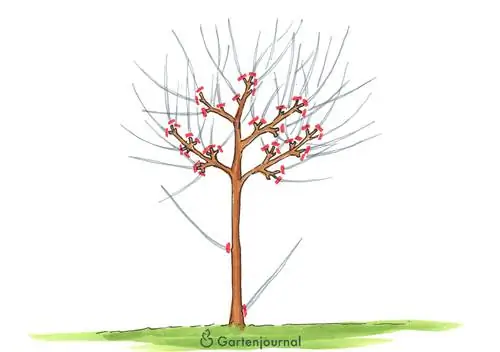
A beautiful crown consists of a central shoot and four leading branches.
Trunk protection
So that the trunk grows straight, it should be fixed to a post. Be careful not to rub the binding into the wood. If the tension is too high, you should loosen the tie rope. Protect the trunk from external influences such as frost. Special plastic trunk protection mats prevent damage from machines and wild animals.
Tip
Bamboo and reed mats or jute wraps can also be installed to protect the trunk.
What is a standard tree?
High trunks refer to fruit trees with a crown base that is 180 to 220 cm high. This information has been a nationwide standard since 1995. This growth habit is achieved through annual pruning measures. In the first few years after sowing, all side branches must be removed. In the third year, the branches remain standing to form the crown. All shoots underneath are cut off.
Excursus
A look into the past
From 1950 to 1995, the norm of crown height was between 160 and 180 cm. Due to the changing use and the increasingly larger tractors that were responsible for cutting orchards, the values had to be increased. Trees with even taller crowns, such as those often found in avenues, are called solitary trees.
Advantages
When a dwarf form is affected by fire blight, the entire plant often has to be cleared. Standard trunks can provide a solution because they can tolerate severe pruning in the affected area. Additional use of green space is possible in orchards with old cultivated varieties. The advantages of the standard tree can also be used in the garden. The crown provides shade and the free trunk area can be used to hang hammocks. In addition, high trunks offer valuable habitats for rare and sometimes endangered species.
Planting distances for standard trees:
- Apple: six to eight meters
- Pear: five to seven meters
- Sweet cherry: six to nine meters
- Plum: four to six meters
- Quince: four to five meters
Frequently asked questions
Can I transplant a standard tree?
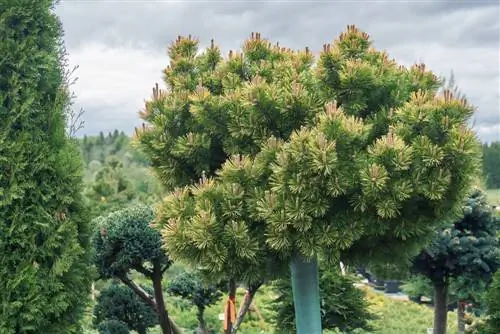
Young trees can still be transplanted quite easily
Young trees can be easily transplanted because they have not yet developed a widely branched root system. The older the trees get, the more difficult this measure becomes. The roots reach deep into the soil and usually cannot be dug out without damage. If transplanting cannot be avoided, you should expose as large a root ball as possible.
How should a standard tree overwinter?
High trunks are more sensitive to wind and weather than trees with a natural growth habit. With grafted varieties, the grafting area under the crown can quickly become damaged. Winter protection is therefore necessary even for winter-hardy plants. Make sure the trunk does not get any morning sun. Strong temperature fluctuations can lead to frost cracks. A reed mat (€21.00 at Amazon) offers the trunk shade. Alternatively, you can apply a white protective coat that reflects sunlight.
How can I underplant the standard tree?
If the tree grows in a sunny location, you are free to choose. Most balcony flowers thrive below the trees. Petunias, snowflake, gold marie and lobelia like light shade, while fuchsias, ivy and begonias grow in shady conditions. Pay attention to a harmonious combination of colors. Contrasts or coordinated arrangements look particularly beautiful. In the pot you can combine bushy with overhanging species to create three levels.
Do standard trees need special care?
The trees are less stable than their relatives with a natural growth habit. You should therefore protect the plants from wind and, if necessary, support them with a stake. Many shrubs tend to sprout at the trunk. Such shoots must be removed early. Regular crown pruning is just as important as an adequate supply of nutrients.
How tall are the low, semi- and high trunks?
On lower trunks, the crown begins at a height of between 80 and 100 centimeters. Half trunks have a crown base at a height of between 100 and 160 centimeters. A nationwide standard has been in effect for tall tribes since 1995. This stipulates that the crown must be between 180 and 220 centimeters.





